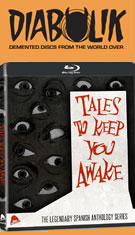
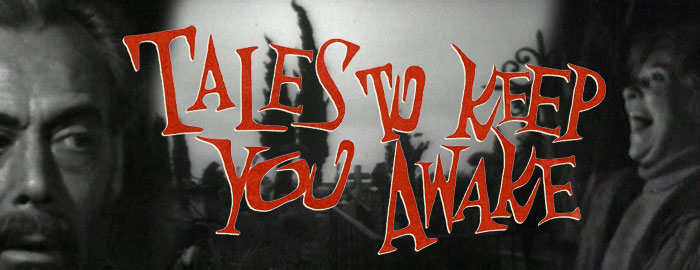
B&W/Color, 1966-1982, 1485 mins.
Directed by Narciso Ibáñez Serrador
Severin Films (Blu-ray) (US R0 SD), Vellavisión (DVD) (Spain R2 PAL)
Inspired by the success of 1960s horror 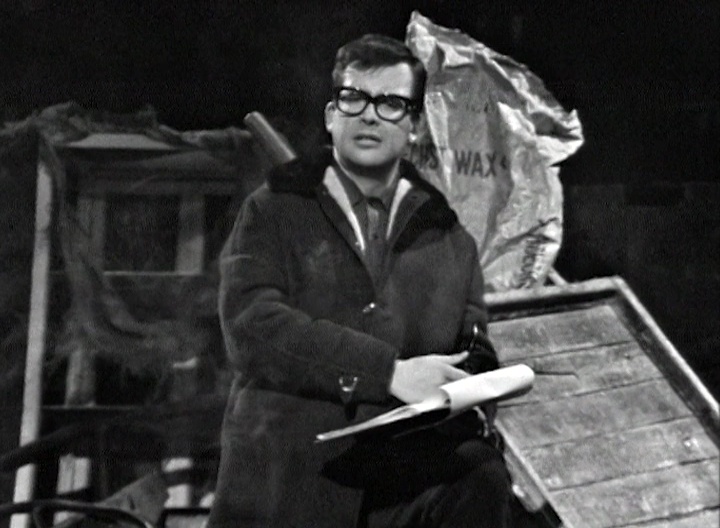 and sci-fi anthology series like Alfred Hitchcock
and sci-fi anthology series like Alfred Hitchcock 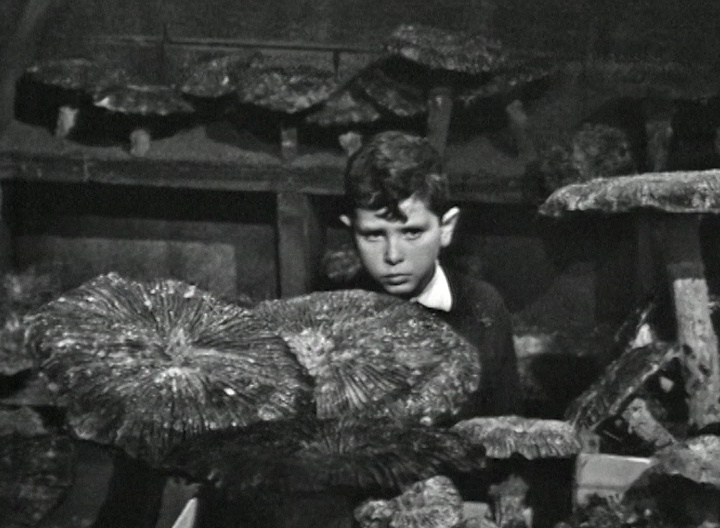 Presents, The Outer Limits, and Thriller, young Spanish filmmaker Narciso Ibáñez Serrador embarked on a quest to host, direct, and largely write the episodes for a homegrown series in the same vein. The result was Historias para no dormir (Tales To Keep You Awake), which started airing in 1966 and ran for two years with a 1974 special and a 1982 miniseries bringing it back for new generations. Serrador managed to scare the pants off of audiences on a far larger scale with two feature films that ended up being distributed in the U.S. by AIP, The House That Screamed and Who Can Kill a Child?, and the format was revived for an excellent 2006 series of films, Películas para no dormir (released in the U.S. as 6 Films To Keep You Awake), and a 2021 Spanish revival paying tribute to Serrador after his death in 2019.
Presents, The Outer Limits, and Thriller, young Spanish filmmaker Narciso Ibáñez Serrador embarked on a quest to host, direct, and largely write the episodes for a homegrown series in the same vein. The result was Historias para no dormir (Tales To Keep You Awake), which started airing in 1966 and ran for two years with a 1974 special and a 1982 miniseries bringing it back for new generations. Serrador managed to scare the pants off of audiences on a far larger scale with two feature films that ended up being distributed in the U.S. by AIP, The House That Screamed and Who Can Kill a Child?, and the format was revived for an excellent 2006 series of films, Películas para no dormir (released in the U.S. as 6 Films To Keep You Awake), and a 2021 Spanish revival paying tribute to Serrador after his death in 2019.
-
"El cumpleaños" ("The Birthday") (18m53s): in this adaptation of a Fredric Brown story, a banker decides to celebrate his 50th birthday by stabbing his wife to death and jetting off to Rio.
-
"La Mano" ("The Hand") (49m53s): A straight-up Spanish dub of the classic Outer Limits episode "The Demon with a Glass Hand" starring Robert Culp. If you already know this one, you can probably skip it -- but nice to have for curiosity value.
-
"La bodega (1ª parte)" (32m9s) and "La bodega (2ª parte)" (26m31s) ("The Cellar") is an atmospheric and quite faithful adaptation of Ray Bradbury's mushroom invasion nightmare "Come into My Cellar," a.k.a. "Boys! Raise Giant Mushrooms in Your Cellar!," also filmed as part of 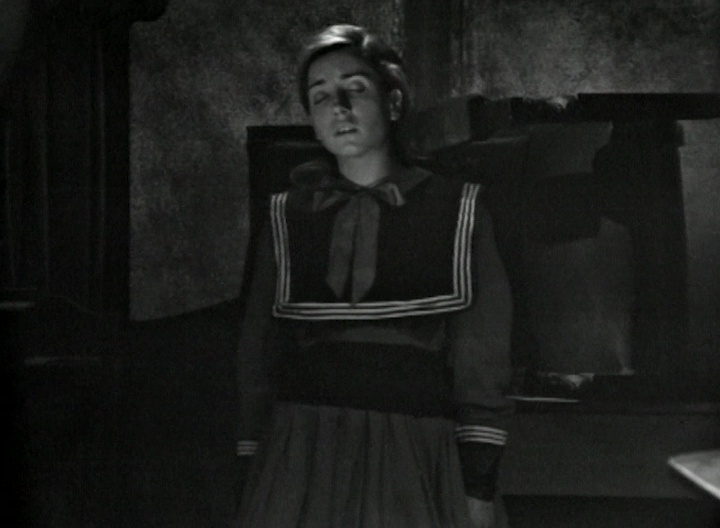 the Ray Bradbury Theater series later on with Charles Martin Smith.
the Ray Bradbury Theater series later on with Charles Martin Smith.
-
"El tonel" ("The Cask") (52m19s): 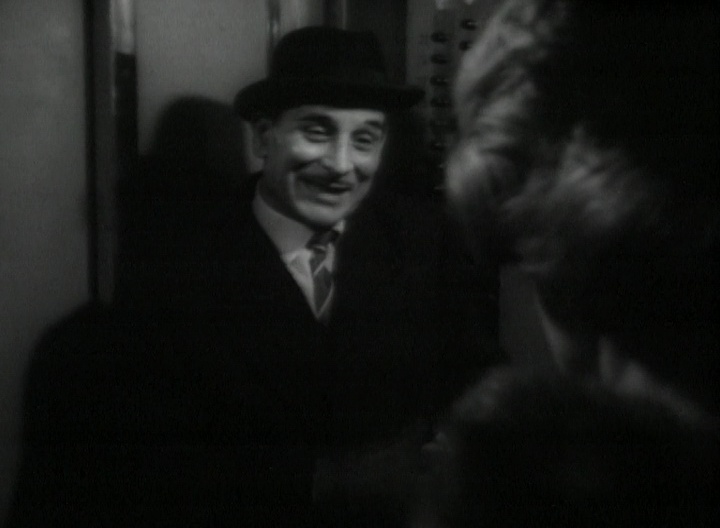 A surprisingly ornate and effective version of Edgar Allan Poe's "The Cask of Amantillado" featuring a strong cast including Gemma Cuervo, Antonio Casas, Jesús Aristu, and the acting debut of a young Ramón Pons before he moved on to everything from Murder in a Blue World to Broken Embraces.
A surprisingly ornate and effective version of Edgar Allan Poe's "The Cask of Amantillado" featuring a strong cast including Gemma Cuervo, Antonio Casas, Jesús Aristu, and the acting debut of a young Ramón Pons before he moved on to everything from Murder in a Blue World to Broken Embraces.
-
"La oferta" ("The Offer") (26m34s): A talky gangster thriller with an ironic twist buoyed by strong lead performances by vets Carlos Larrañaga and Concha Cuetos.
-
"El doble" ("The Double") (34m55s): Another Bradbury adaptation, this time from "Marionettes, Inc." with Luis Predes (Devil's Exorcist, China 9 Liberty 37) deciding to order a robot duplicate of himself after finding out a buddy of his has been doing the same thing to get away from his overly attentive wife.
-
"El pacto" ("The Pact") (64m1s): A greatly elaborated version of Poe's "The Facts in the Case of M. Valdemar" (also featured in Two Evil Eyes, Tales of Terror, and Master of Horror) about an asylum doctor whose insistence on breaking new ground in mesmerism goes very, very wrong. Spanish comedy veteran Narciso Ibáñez Menta (Serrador's father) gets a good showcase here in what would be the first of eleven appearances on the show.
-
"El muñeco" ("The Doll") (51m31s): Fans of The House That Dripped Blood will really get a kick out of this earlier adaptation of the Robert Bloch short story "Sweets to the Sweet," which was filmed for that Amicus anthology with Christopher Lee. Also lifting some heavy elements from Jack Clayton's The Innocents (to such an extent that Henry James as gets a story credit), this one is a really well done as it charts a new governess' discomfort with a father's seemingly cruel treatment of her young charge who has a habit of slipping 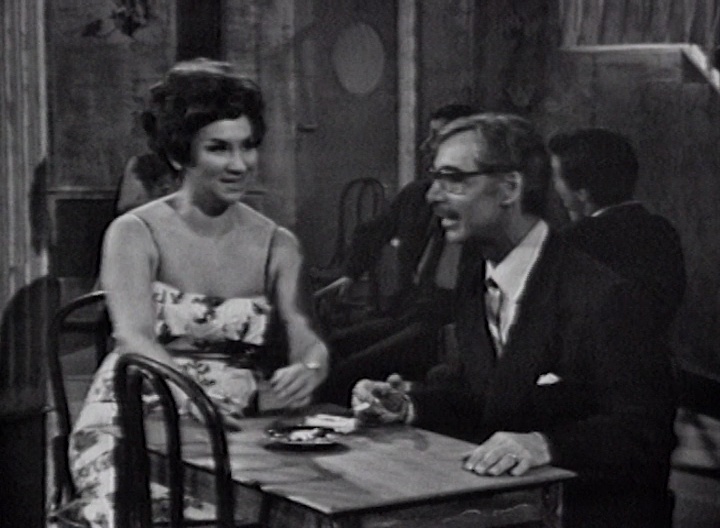 away to perform weird rites in the attic. This one even has a more twisted ending, too.
away to perform weird rites in the attic. This one even has a more twisted ending, too.
-
"El cohete" ("The Rocket") (45m41s): 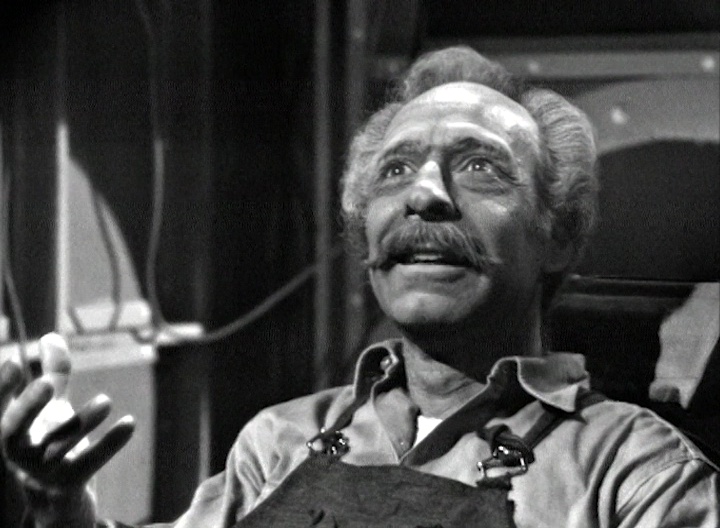 Back to Bradbury again with a more sweet and sentimental tale about an old man fixated on interstellar rocket launches who wants to send one of his family members up to the stars. When they don't want to split up, he comes up with a plan of his own.
Back to Bradbury again with a more sweet and sentimental tale about an old man fixated on interstellar rocket launches who wants to send one of his family members up to the stars. When they don't want to split up, he comes up with a plan of his own.
-
"La broma" ("The Joke") (35m1s): Menta stars as an obnoxious, perpetual prankster whose wife and her lover decide it's time to bump him off. However, the plan proves to be a lot trickier than they imagined. Very Hitchcockian.
-
"La cabaña" ("The Cabin") (32m45s): A simple, tense little number about a pair of female friends snowbound in a cabin together with only a burning fire and each other's company to pass the time. However, when tragedy strikes in the middle of the night, things take a much more desperate and grim turn.
-
"El aniversario" ("The Anniversary") (30m50s): A year to the day after his retirement as police superintendent, widower Mr. Stinger (Fernando Delgado) celebrates the end of two decades of work by throwing a celebration at his home out in the middle of the countryside. However, the story of how he got his first big promotion 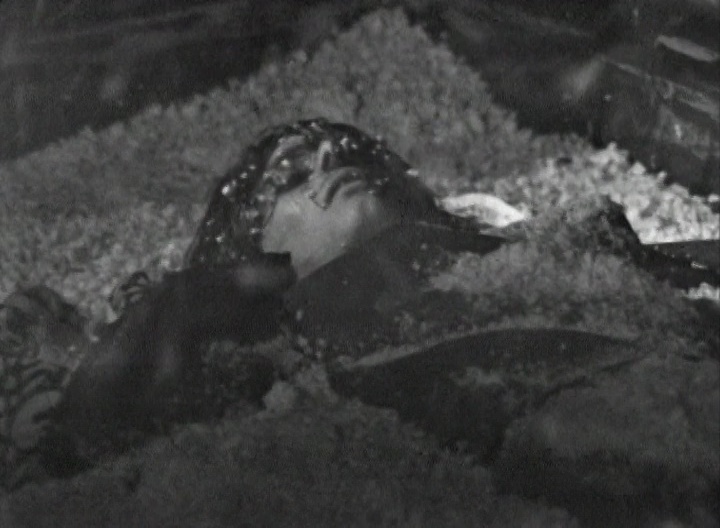 during a firefight with a notorious gangster holds special significance for one of his guests... Another crime story, this one ups the violence quotient and works well as a dark two-hander of sorts between its
during a firefight with a notorious gangster holds special significance for one of his guests... Another crime story, this one ups the violence quotient and works well as a dark two-hander of sorts between its 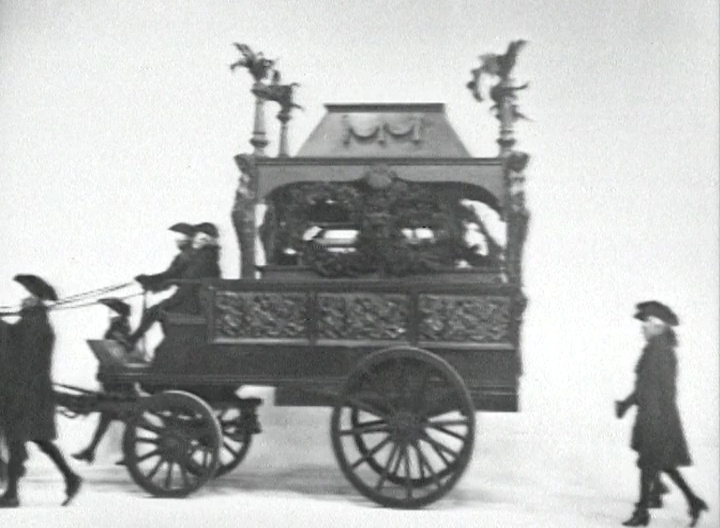 main characters.
main characters.
-
"La espera" ("The Wait") (41m47s): Back to Bradbury again for a melancholy Martian Chronicles tale (based on "The Long Wait") about a nuclear family and their maid, the last remaining civilians at a Mars settlement. When a ship from Earth arrives to seemingly retrieve them, things aren't quite as they appear.
-
"La alarma (1ª parte)" (36m19s) and "La alarma (2ª parte)" (46m21s) ("The Alarm") : A Serrador-penned two-parter depicting the media frenzy that erupts when aliens start to approach Earth, which dovetails into the activities of a physicist who thinks he could be responsible after discovering that a local woman is emitting unusual amounts of radiation for reasons unknown. There's a very Nigel Kneale vibe to this one, which plays out on a much bigger canvas than previous episodes.
-
"La sonrisa" ("The Smile") (30m30s): Ray Bradbury time again for an adaptation of his story of the same title, in which a post-apocalyptic society living in squalor has lost the ability to smile. Their disdain for art and culture of their past civilization extends to a public ritual whose hateful nature doesn't extend to one young man.
-
"El asfalto" ("The Asphalt") (35m27s): A very radical change of pace, this one has no standard opener and features Menta again against painted, cartoonish backdrops as a man who gets stuck to the sidewalk with no way of getting aid in his predicament.
Disc two features the remainder of the series, namely season two, a TV special, and the belated four-part season three from 1982. Here's what you get:
-
"La 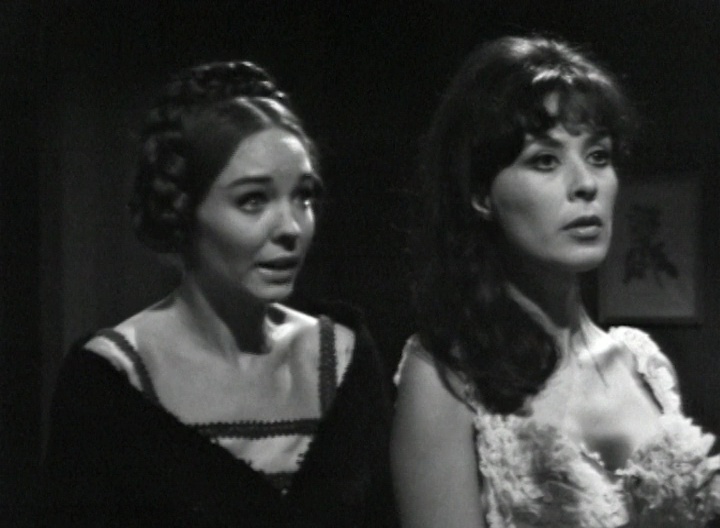 pesadilla" ("The Nightmare") (48m22s): After Serrador hams it up with a skull, here's a spooky period piece about a village under siege by a vampire -- but the residents are wrestling with the morality of having to take out the most likely suspect. It's more or less a variation on Tolstoy's "The Family of the Vourdalak" (famously filmed by Mario Bava for Black Sabbath and later as The Night of the Devils), right down to referring to its monster as a Wurdulak, though the narrative here is quite different and culminates in a rare moment of gore for the series. Great Gothic Spanish horror and not a bad place to start with the set.
pesadilla" ("The Nightmare") (48m22s): After Serrador hams it up with a skull, here's a spooky period piece about a village under siege by a vampire -- but the residents are wrestling with the morality of having to take out the most likely suspect. It's more or less a variation on Tolstoy's "The Family of the Vourdalak" (famously filmed by Mario Bava for Black Sabbath and later as The Night of the Devils), right down to referring to its monster as a Wurdulak, though the narrative here is quite different and culminates in a rare moment of gore for the series. Great Gothic Spanish horror and not a bad place to start with the set.
-
"La zarpa" ("The Paw") (47m25s): As you can probably guess from the title, this one is an expanded riff on W.W. Jacobs' classic horror short story "The Monkey's Paw," about a couple bestowed with a preserved paw capable of granting them three wishes -- all of which have a very dark side. Complete with a prologue showing the paw's origins, this is a solid adaptation pulled off with plenty of panache.
-
"El vidente" ("The Seer") (50m27s): In this parapsychology thriller featuring an appearance by a very young Marisa Paredes (future Pedro Almodóvar regular and In a Glass Cage star), a string of suspicious suicides is baffling the police. A psychic thinks they and the lives of  those they've touched are all tied by something inexplicable, a fog-like apparition, that not only causes agitation but could spell even more deaths. A modest but spooky little number that anticipates the flood of ESP chillers that would come throughout the '70s, with a little splash of Final Destination to boot.
those they've touched are all tied by something inexplicable, a fog-like apparition, that not only causes agitation but could spell even more deaths. A modest but spooky little number that anticipates the flood of ESP chillers that would come throughout the '70s, with a little splash of Final Destination to boot.
-
"El regreso" ("The Return") (57m24s): Two nephews get wind of the fact that their rich uncle has no plans to include them in his will, so they conspire to pay a visit and get their revenge even if it means committing murder. A fun little E.C. Comics-style yarn with a nice, tense final half hour; this one obviously hasn't survived as well over the ages since it has a fair amount of distortion and noise throughout.
-
"El cuervo" ("The Raven") (48m46s): As you can probably guess from the title, this one is based on Edgar Allan Poe with a meta twist as the author himself takes center stage during his stint as a beleaguered newspaper editor. Anticipating what Stuart Gordon would do decades later on Masters of Horror with "The Black Cat," this one leads up to his final days in Baltimore (albeit with a Spanish twist) along with parallels to the many macabre tragedies in his work -- along with a pivotal raven at his writing desk.
-
"La promesa" ("The Promise") (49m11s): More Poe territory with this one, at least in spirit, set in 1840 Ireland as an undertaker with a paralyzing fear of being buried alive makes his oppressed niece promise she'll ensure that fate never befalls him. Another entertaining one very 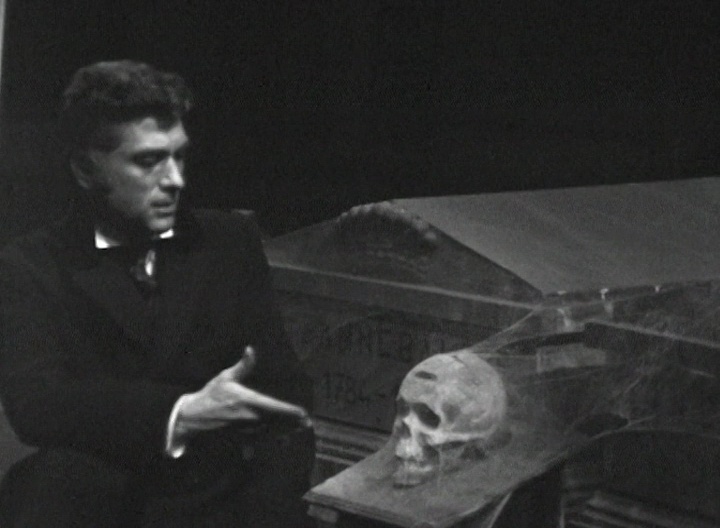 heavily influenced by the Roger
heavily influenced by the Roger 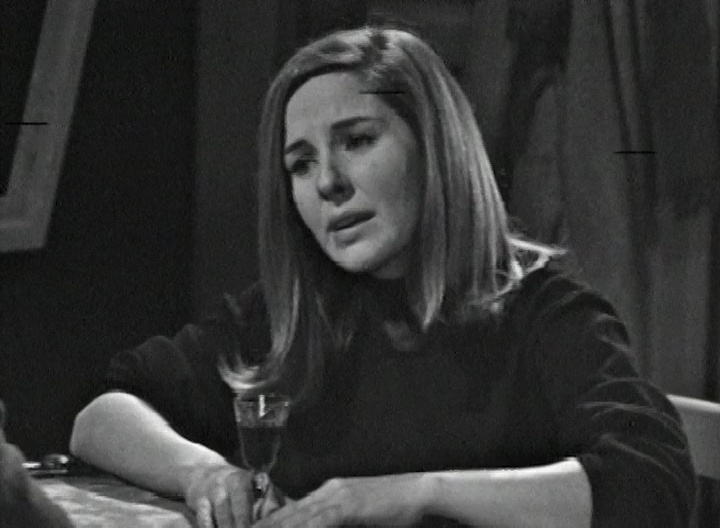 Corman films earlier that decade.
Corman films earlier that decade.
-
"La casa" ("The House") (45m55s): When Countess Alaja dies under mysterious circumstances with rumors of murder in the air, the villagers believe her impulsive spirit will destroy anyone who tries to take control of her house. Many years later, the Count's great-grandson decides to move in, the stage is set for a very twisty, terrifying night with lots of thunder, candles, and a possible territorial ghost. One of the series' most atmospheric episodes, this is a perfect one to watch around midnight.
-
"El transplante" ("The Transplant") (61m24s): The arty stylized approach of "The Asphalt" returns for this semi-comical sci-fi musical(!) story about a future in which all kinds of transplants have become completely commonplace, to the point that anyone who doesn't go along is branded a heretic. It takes a more contemplative and sentimental turn at the end about the value of being different, and it's likely this will be among the most divisive entries in the set.
-
"El televisor" ("The TV") (68m40s): Now we switch to color with this one-off 1974 special about Enrique (Menta), a hard-working guy pulling two jobs (at a bank and a farm) juggling his family life with his wife and two teenage kids. In keeping with the show's format change, he yearns for one pleasure in life: a new color television, something that will not only upend his domestic life but alter the fabric of his very reality itself. An unnerving entry, this one takes an aggressive stance against excessive media consumption in a way that probably felt like a 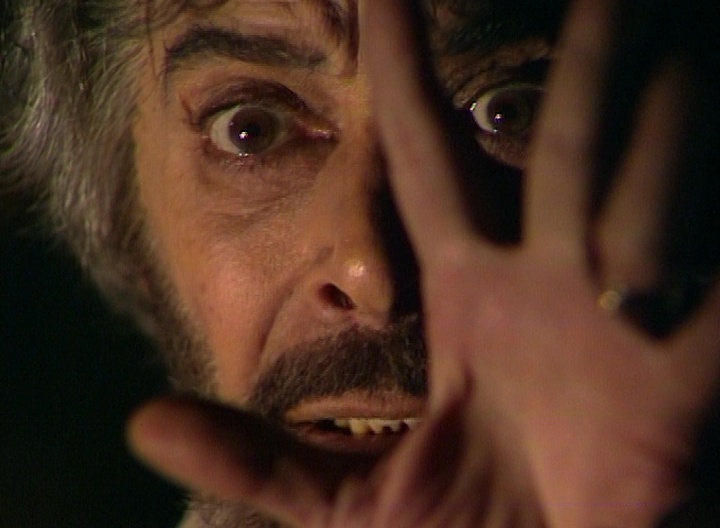 smack across the
smack across the 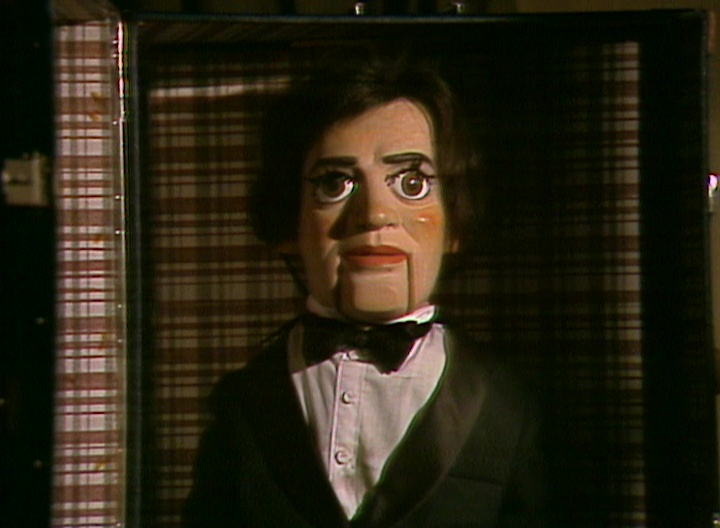 face at the time complete with a gut punch of an ending.
face at the time complete with a gut punch of an ending.
-
"Freddy" (109m): In 1982 the series came back as a limited four-part revival starting with this roaring comeback premiere, which feels like a giallo-flavored take on creepy dummy stories like Dead of Night, Magic, and Dead Silence. Murder strikes a traveling French theatrical troupe including a territorial ventriloquist, a sexually aggressive magician, and a lot of showgirls; who could be going around bonking people on the head and attacking them with scissors? One of the very best episodes, this one really pays off with a great twist ending.
-
"El caso del Señor Valdemar" ("The Case of Mr. Valdemar") (65m50s): Revisiting territory from "The Pact," here's a color redo of Poe's classic short story with the intensity level ramped way up along with some gorgeous shadowy photography and an ickier punchline at the end.
-
"El fin empezó ayer" ("The End Began Yesterday") (64m33s): At an urban college, one student in particular seems to be way ahead of his peers but finds himself being stonewalled by one of his professors. While the rest of the kids are distracted with gossip and dating, death is soon stalking in their midst -- 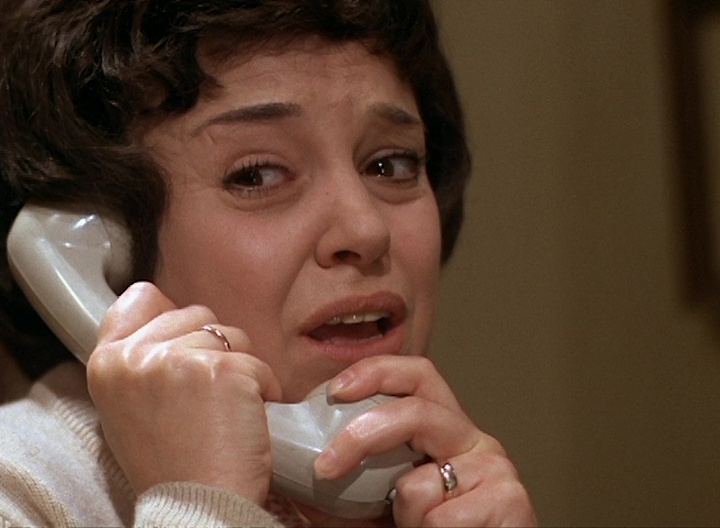 and in flashback the professor explains the horrifying truth that could be on a very large scale. Another nicely done one, including a fun visual callback to a classic moment from The House That Screamed.
and in flashback the professor explains the horrifying truth that could be on a very large scale. Another nicely done one, including a fun visual callback to a classic moment from The House That Screamed.
-
"El trapedo" ("The Junkman") (79m26s): The last and longest of the bunch brings Menta back one more 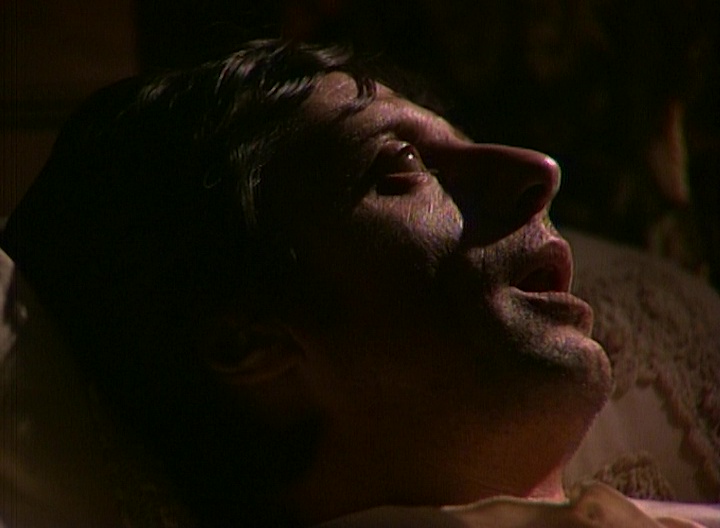 time as Edmond, an elderly ragman in late 1800s London who comes to suspect that his son might be connected to the repeated violations of graves in the neighborhood. The fact that a major character is named Berenice should tip some viewers off that this is another Poe variation, with a dark, grimy period setting that creates a feeling of doom right from the beginning to the final eerie closing shot.
time as Edmond, an elderly ragman in late 1800s London who comes to suspect that his son might be connected to the repeated violations of graves in the neighborhood. The fact that a major character is named Berenice should tip some viewers off that this is another Poe variation, with a dark, grimy period setting that creates a feeling of doom right from the beginning to the final eerie closing shot.
Disc two also houses the video extras for the start starting with "Tales From The Spanish Twilight Zone: The Chicho Ibáñez Serrador Story" (29m55s), with Dr. Alex Mendibil providing a great overview of the filmmaker's rise through the world of Spanish TV and his importance to the local horror genre, including glimpses of a few other connected TV episodes that would be great to see someday. Ported over from the series' 2005 Spanish DVD release (which wasn't English friendly) are six intros by Serrador looking back at select episodes (covering two or three at a time), plus a press conference for "El televisor" (6m45s) talking about the episode's significance and potentially transgressive nature at the time. Image-wise, the series was almost entirely shot on videotape (the color ones were 16mm) and thus is presented here from the surviving SD masters at 30 fps (not upscaled) with optional yellow English subtitles. Some age-related anomalies pop up now and then including some fleeting tape damage, which has always been the case with this show. The Dolby Digital Spanish mono audio is also fine and limited by the nature of the source, and the music is enormously effective, mostly composed by regular Serrador composer Waldo de los Ríos with some clear musical ideas that would turn up in their later big screen work together.
Reviewed on October 25, 2022.



 and sci-fi anthology series like Alfred Hitchcock
and sci-fi anthology series like Alfred Hitchcock  Presents, The Outer Limits, and Thriller, young Spanish filmmaker Narciso Ibáñez Serrador embarked on a quest to host, direct, and largely write the episodes for a homegrown series in the same vein. The result was Historias para no dormir (Tales To Keep You Awake), which started airing in 1966 and ran for two years with a 1974 special and a 1982 miniseries bringing it back for new generations. Serrador managed to scare the pants off of audiences on a far larger scale with two feature films that ended up being distributed in the U.S. by AIP, The House That Screamed and Who Can Kill a Child?, and the format was revived for an excellent 2006 series of films, Películas para no dormir (released in the U.S. as 6 Films To Keep You Awake), and a 2021 Spanish revival paying tribute to Serrador after his death in 2019.
Presents, The Outer Limits, and Thriller, young Spanish filmmaker Narciso Ibáñez Serrador embarked on a quest to host, direct, and largely write the episodes for a homegrown series in the same vein. The result was Historias para no dormir (Tales To Keep You Awake), which started airing in 1966 and ran for two years with a 1974 special and a 1982 miniseries bringing it back for new generations. Serrador managed to scare the pants off of audiences on a far larger scale with two feature films that ended up being distributed in the U.S. by AIP, The House That Screamed and Who Can Kill a Child?, and the format was revived for an excellent 2006 series of films, Películas para no dormir (released in the U.S. as 6 Films To Keep You Awake), and a 2021 Spanish revival paying tribute to Serrador after his death in 2019.  the Ray Bradbury Theater series later on with Charles Martin Smith.
the Ray Bradbury Theater series later on with Charles Martin Smith.  A surprisingly ornate and effective version of Edgar Allan Poe's "The Cask of Amantillado" featuring a strong cast including Gemma Cuervo, Antonio Casas, Jesús Aristu, and the acting debut of a young Ramón Pons before he moved on to everything from Murder in a Blue World to Broken Embraces.
A surprisingly ornate and effective version of Edgar Allan Poe's "The Cask of Amantillado" featuring a strong cast including Gemma Cuervo, Antonio Casas, Jesús Aristu, and the acting debut of a young Ramón Pons before he moved on to everything from Murder in a Blue World to Broken Embraces. away to perform weird rites in the attic. This one even has a more twisted ending, too.
away to perform weird rites in the attic. This one even has a more twisted ending, too.  Back to Bradbury again with a more sweet and sentimental tale about an old man fixated on interstellar rocket launches who wants to send one of his family members up to the stars. When they don't want to split up, he comes up with a plan of his own.
Back to Bradbury again with a more sweet and sentimental tale about an old man fixated on interstellar rocket launches who wants to send one of his family members up to the stars. When they don't want to split up, he comes up with a plan of his own. during a firefight with a notorious gangster holds special significance for one of his guests... Another crime story, this one ups the violence quotient and works well as a dark two-hander of sorts between its
during a firefight with a notorious gangster holds special significance for one of his guests... Another crime story, this one ups the violence quotient and works well as a dark two-hander of sorts between its  main characters.
main characters. pesadilla" ("The Nightmare") (48m22s): After Serrador hams it up with a skull, here's a spooky period piece about a village under siege by a vampire -- but the residents are wrestling with the morality of having to take out the most likely suspect. It's more or less a variation on Tolstoy's "The Family of the Vourdalak" (famously filmed by Mario Bava for Black Sabbath and later as The Night of the Devils), right down to referring to its monster as a Wurdulak, though the narrative here is quite different and culminates in a rare moment of gore for the series. Great Gothic Spanish horror and not a bad place to start with the set.
pesadilla" ("The Nightmare") (48m22s): After Serrador hams it up with a skull, here's a spooky period piece about a village under siege by a vampire -- but the residents are wrestling with the morality of having to take out the most likely suspect. It's more or less a variation on Tolstoy's "The Family of the Vourdalak" (famously filmed by Mario Bava for Black Sabbath and later as The Night of the Devils), right down to referring to its monster as a Wurdulak, though the narrative here is quite different and culminates in a rare moment of gore for the series. Great Gothic Spanish horror and not a bad place to start with the set. those they've touched are all tied by something inexplicable, a fog-like apparition, that not only causes agitation but could spell even more deaths. A modest but spooky little number that anticipates the flood of ESP chillers that would come throughout the '70s, with a little splash of Final Destination to boot.
those they've touched are all tied by something inexplicable, a fog-like apparition, that not only causes agitation but could spell even more deaths. A modest but spooky little number that anticipates the flood of ESP chillers that would come throughout the '70s, with a little splash of Final Destination to boot. heavily influenced by the Roger
heavily influenced by the Roger  Corman films earlier that decade.
Corman films earlier that decade.  smack across the
smack across the  face at the time complete with a gut punch of an ending.
face at the time complete with a gut punch of an ending. and in flashback the professor explains the horrifying truth that could be on a very large scale. Another nicely done one, including a fun visual callback to a classic moment from The House That Screamed.
and in flashback the professor explains the horrifying truth that could be on a very large scale. Another nicely done one, including a fun visual callback to a classic moment from The House That Screamed. time as Edmond, an elderly ragman in late 1800s London who comes to suspect that his son might be connected to the repeated violations of graves in the neighborhood. The fact that a major character is named Berenice should tip some viewers off that this is another Poe variation, with a dark, grimy period setting that creates a feeling of doom right from the beginning to the final eerie closing shot.
time as Edmond, an elderly ragman in late 1800s London who comes to suspect that his son might be connected to the repeated violations of graves in the neighborhood. The fact that a major character is named Berenice should tip some viewers off that this is another Poe variation, with a dark, grimy period setting that creates a feeling of doom right from the beginning to the final eerie closing shot. ![]()